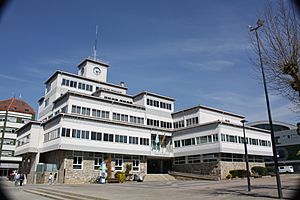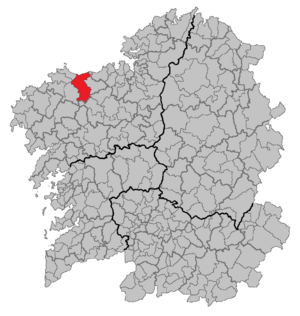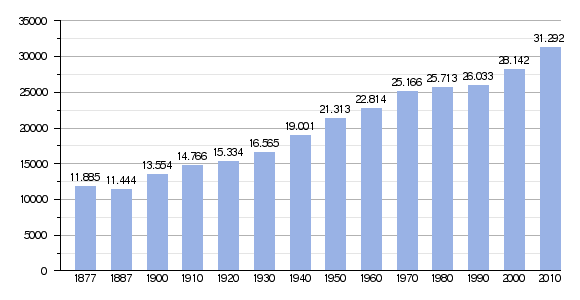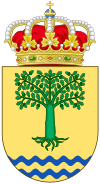Carballo facts for kids
Quick facts for kids
Carballo
|
|||
|---|---|---|---|

Town hall.
|
|||
|
|||

Location of Carballo
|
|||
| Country | |||
| Autonomous community | |||
| Province | A Coruña | ||
| Comarca | Comarca de Bergantiños | ||
| Area | |||
| • Total | 186.09 km2 (71.85 sq mi) | ||
| Elevation | 106 m (348 ft) | ||
| Population
(2018)
|
|||
| • Total | 31,261 | ||
| • Density | 167.989/km2 (435.088/sq mi) | ||
| Demonym(s) | Carballés, carballesa | ||
| Time zone | UTC+1 (CET) | ||
| • Summer (DST) | UTC+2 (CEST) | ||
| Postal code |
15100
|
||
| Dialing code | 981 | ||
Carballo is a town in the Province of A Coruña in northwestern Spain. It is part of the Galicia region. Carballo is the thirteenth most populated town in Galicia. It is also the capital of the Bergantiños area.
The well-known seafood company Calvo has its main office here.
Contents
What Does Carballo Mean?
The name Carballo comes from a Galician word. It means "oak trees." Oak trees are a very important symbol for this town.
Long ago, people often spelled names differently. This was because many people could not read or write. So, names like Carballo might have been written down based on how they sounded. This led to different spellings over time.
A Look at Carballo's History
Carballo's history goes back a long way, to the year 759 AD. The town was named for the many oak forests around it. It is also close to the Atlantic Ocean. This makes it a good place for travel and trade.
The town is also lucky to have several rivers. The Anllóns River flows through a beautiful natural area called Razo-Baldaio. This adds to the lovely scenery.
How Carballo Became a Municipality
Carballo officially became a municipality in 1836. A municipality is like a local government area. In 1920, a new Town Hall was built. It was designed by an Architect named Julio Galan.
The town grew a lot in the 1920s and 1930s. New schools were built, and more open spaces were created. From the 1960s to the 1980s, Carballo saw even more growth. This was due to the mining of Tungsten, a valuable metal.
Ancient Waters and Roman Influence
Carballo has been known since ancient times for its special waters. These are sulfurous waters, also called Vellos or Baths. People believed they had healing powers. Even today, these waters are sold for their health benefits.
The Romans also came to Carballo. They were interested in the fertile land and the minerals. They also liked the sulfurous waters. You can still see Roman history here. The remains of a Roman spa town have been found. The Lubiáns Bridge is another example of Roman building. It stands high above the Rosende river.
Carballo's Culture and Heritage
Carballo has a rich history that you can see in its old buildings and sites.
Ancient Sites and Structures
- Megalithic Era: This was a time when people built with large stones. Carballo has a famous dolmen called the "Pedra Moura." A dolmen is a type of ancient tomb made of big stones.
- Castreña Culture: This culture built strong forts called castros. Some examples are the Castro of Cances and Castro Torre Pardiñas. These forts show how people lived and defended themselves long ago. Studies suggest the region's name, Bergantiños, might come from a Celtic tribe called the Brigantinos.
From Roman times, there are not many remains. But the fort of Torre Pardiñas shows Roman building ideas. The Roman Bridge of Lubiáns was part of an old Roman road.
Religious Buildings
Carballo has many interesting churches.
- The Church of Rus was built between the 1600s and 1700s. It has a beautiful Baroque style. Inside, you can see a large silver cross.
- Other churches like those in Entrecruces and Sofán also show Baroque styles. The church of Oza has a stone carving of St. Breixo on its front.
Many churches from the 1900s also have Baroque altarpieces. The church of Razo has images of St. John the Baptist. The church of Bertoia has a Gothic Christ statue.
Traditional Architecture
You can also find examples of traditional buildings in Carballo.
- Stone Crosses: These are old stone monuments found in places like Sofán and Ardana.
- Breastplates of Souls: These are small shrines.
- Granaries: These are buildings used to store grain. You can see them in places like Brea.
- Mills: These are buildings that used water power to grind grain. Examples include A Cheda and Ponte Rosende.
The Rebordelos area is special. It has a mámoa (another type of ancient burial mound). It also has a Celtic castro and several old mansions. The church of San Salvador is in the town center. Rebordelos is right by the Atlantic Ocean. It has beautiful beaches like A Lapeira and Arnela.
Several old palaces are still in Carballo. These include the Palace of Pallas and the Gontade Palace. There is also a 19th-century building that used to be a jail. It is now the Museum of Bergantinos.
Carballo's Population
Carballo has about 31,466 people living there. This means it has about 167 people per square kilometer.
The chart below shows how Carballo's population has changed over many years. You can see that the number of people living in Carballo has grown quite a lot since the late 1800s.

Famous People from Carballo
Many talented people have come from Carballo:
- Alfredo Brañas Menéndez (born 1859) - A writer who supported the Galician regionalist movement.
- Fernando Cabeza Quiles (born 1953) - Known for his work on the names of places in Galicia.
- Xurxo Borrazás (born 1963) - A Galician writer and translator.
- Rober Bodegas (born 1982) - A comedian who has appeared on Spanish TV.
- Arturo Castañeda Cid (born 1973) - A bodybuilder and PE teacher. He has won many awards in Galicia and Spain.
Carballo's Sister Cities
Carballo has a special connection with another town far away. This is called a "sister city" relationship.
Images for kids
See also
 In Spanish: Carballo (La Coruña) para niños
In Spanish: Carballo (La Coruña) para niños








